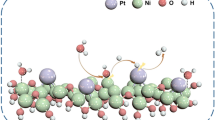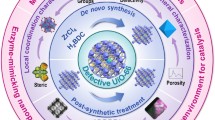Abstract
Although many previous studies have shown that the shape-control of nanocrystal (NCs) is an efficient strategy to improve the catalytic performance, these syntheses were conducted under very different conditions, which are not suitable for the shape-dependent properties studies as well as catalysis optimization. Herein, we demonstrate an effective method for the selective synthesis of well-defined PtPb NCs in a highly controllable manner. Four distinct PtPb NCs, namely PtPb peanut nanocrystals, PtPb hexagonal nanoplates, PtPb octahedra nanocrystals (ONCs) and PtPb nanoparticles have been selectively prepared in the presence of different phenols. Significantly, we found that the created PtPb NCs/C shows the shape-dependent activity with the optimized PtPb ONCs/C being the most active for the ethanol reforming to H2, 22.4 times higher than the commercial Pt/C. The high performance of PtPb ONCs/C has been also successfully expanded into other polyhydric alcohols reformings. X-ray photoelectron spectroscopy (XPS) reveals that the high Pt(0)/Pt(II) ratio in PtPb NCs/C enhances the alcohols reforming. The density functional theory (DFT) studies show the PtPb ONCs possess the highest surface averaged electronic occupation for unit Pt-atom, matching well with XPS results. The PtPb ONCs/C also displays excellent durability with limited activity decay and negligible structure/composition changes after ten cycles. This work demonstrates an important advance in the high-level control of metallic nanostructures to tune the catalytic activities.

Similar content being viewed by others
References
Stolten, D. Hydrogen and Fuel Cells: Fundamentals, Technologies and Applications; Wiley-VCH: Weinheim, Germany, 2010.
Steele, B. C. H.; Heinzel, A. Materials for fuel-cell technologies. Nature 2001, 414, 345–352.
Schlapbach, L.; Zuttel, A. Hydrogen-storage materials for mobile applications. Nature 2001, 414, 353–358.
Jin, H. Y.; Wang, J.; Su, D. F.; Wei, Z. Z.; Peng, Z. F.; Wang, Y. In situ cobalt-cobalt oxide/n-doped carbon hybrids as superior bifunctional electrocatalysts for hydrogen and oxygen evolution. J. Am. Chem. Soc. 2015, 137, 2688–2694.
Wang, B.; Zeng, C. P.; Chu, K.; Wu, D.; Yip, H. Y.; Ye, L. Q.; Wong, P. K. Enhanced biological hydrogen production from Escherichia coli with surface precipitated cadmium sulfide nanoparticles. Adv. Energy Mater. 2017, 7, 1700611.
Ochoa, A.; Aramburu, B.; Valle, B.; Resasco, D. E.; Bilbao, J.; Gayubo, A. G.; Castaño, P. Role of oxygenates and effect of operating conditions in the deactivation of a Ni supported catalyst during the steam reforming of bio-oil. Green Chem. 2017, 19, 4315–4333.
Laprune, D.; Farrusseng, D.; Schuurman, Y.; Meunier, F. C.; Pieterse, J. A. Z.; Steele, A. M.; Thorpe, S. Effects of H2S and phenanthrene on the activity of Ni and Rh-based catalysts for the reforming of a simulated biomass-derived producer gas. Appl. Catal. B: Environ. 2018, 221, 206–214.
David, W. I. F.; Makepeace, J. W.; Callear, S. K.; Hunter, H. M. A.; Taylor, J. D.; Wood, T. J.; Jones, M. O. Hydrogen production from ammonia using sodium amide. J. Am. Chem. Soc. 2014, 136, 13082–13085.
Yu, K. M. K.; Tong, W. Y.; West, A.; Cheung, K.; Li, T.; Smith, G.; Guo, Y. L.; Tsang, S. C. E. Non-syngas direct steam reforming of methanol to hydrogen and carbon dioxide at low temperature. Nat. Commun. 2012, 3, 1230.
Zhang, S.; Metin, Ö.; Su, D.; Sun, S. H. Monodisperse AgPd alloy nanoparticles and their superior catalysis for the dehydrogenation of formic acid. Angew. Chem., Int. Ed. 2013, 52, 3681–3684.
Palo, D. R.; Dagle, R. A.; Holladay, J. D. Methanol steam reforming for hydrogen production. Chem. Rev. 2007, 107, 3992–4021.
Cortright, R. D.; Davda, R. R.; Dumesic, J. A. Hydrogen from catalytic reforming of biomass-derived hydrocarbons in liquid water. Nature 2002, 418, 964–967.
Johnson, T. C.; Morris, D. J.; Wills, M. Hydrogen generation from formic acid and alcohols using homogeneous catalysts. Chem. Soc. Rev. 2010, 39, 81–88.
Lin, L. L.; Zhou, W.; Gao, R.; Yao, S. Y.; Zhang, X.; Xu, W. Q.; Zheng, S. J.; Jiang, Z.; Yu, Q. L.; Li, Y. W. et al. Low-temperature hydrogen production from water and methanol using Pt/α-MoC catalysts. Nature 2017, 544, 80–83.
Zhai, Y. P.; Pierre, D.; Si, R.; Deng, D. L.; Ferrin, P.; Nilekar, A. U.; Peng, G. W.; Herron, J. A.; Bell, D. C.; Saltsburg, H. et al. Alkali-stabilized Pt-OHx species catalyze low-temperature water-gas shift reactions. Science 2010, 329, 1633–1636.
Shabaker, J. W.; Davda, R. R.; Huber, G. W.; Cortright, R. D.; Dumesic, J. A. Aqueous-phase reforming of methanol and ethylene glycol over alumina-supported platinum Catalysts. J. Catal. 2003, 215, 344–352.
Khan, M. U.; Wang, L. B.; Liu, Z.; Gao, Z. H.; Wang, S. P.; Li, H. L.; Zhang, W. B.; Wang, M. L.; Wang, Z. F.; Ma, C. et al. Pt3Co octapods as superior catalysts of CO2 hydrogenation. Angew. Chem., Int. Ed. 2016, 55, 9548–9552.
Zhang, H. J.; Watanabe, T.; Okumura, M.; Haruta, M.; Toshima, N. Catalytically highly active top gold atom on palladium nanocluster. Nat. Mater. 2012, 11, 49–52.
Wang, L. B.; Zhao, S. T.; Liu, C. X.; Li, C.; Li, X.; Li, H. L.; Wang, Y. C.; Ma, C.; LI, Z. Y.; Zeng, J. Aerobic oxidation of cyclohexane on catalysts based on twinned and single-crystal Au75Pd25 bimetallic nanocrystals. Nano Lett. 2015, 15, 2875–2880.
Wu, J. B.; Qi, L.; You, H. J.; Gross, A.; Li, J.; Yang, H. Icosahedral platinum alloy nanocrystals with enhanced electrocatalytic activities. J. Am. Chem. Soc. 2012, 134, 11880–11883.
Chen, C.; Kang, Y. J.; Huo, Z. Y.; Zhu, Z. W.; Huang, W. Y.; Xin, H. L.; Snyder, J. D. G.; Li, D. G.; Herron, J. A.; Mavrikakis, M. et al. Highly crystalline multimetallic nanoframes with three-dimensional electrocatalytic surfaces. Science 2014, 343, 1339–1343.
Cui, C. H.; Gan, L.; Heggen, M.; Rudi, S.; Strasser, P. Compositional segregation in shaped Pt alloy nanoparticles and their structural behaviour during electrocatalysis. Nat. Mater. 2013, 12, 765–771.
Habas, S. E.; Lee, H.; Radmilovic, V.; Somorjai, G. A.; Yang, P. D. Shaping binary metal nanocrystals through epitaxial seeded growth. Nat. Mater. 2007, 6, 692–697.
Zhang, S.; Zhang, X.; Jiang, G. M.; Zhu, H. Y.; Guo, S. J.; Su, D.; Lu, G.; Sun, S. H. Tuning nanoparticle structure and surface strain for catalysis optimization. J. Am. Chem. Soc. 2014, 136, 7734–7739.
Xu, D.; Liu, Z. P.; Yang, H. Z.; Liu, Q. S.; Zhang, J.; Fang, J. Y.; Zou, S. Z.; Sun, K. Solution-based evolution and enhanced methanol oxidation activity of monodisperse platinum-copper nanocubes. Angew. Chem., Int. Ed. 2009, 48, 4217–4221.
Zhang, J.; Yang, H. Z.; Fang, J. Y.; Zou, S. Z. Synthesis and oxygen reduction activity of shape-controlled Pt3Ni nanopolyhedra. Nano Lett. 2010, 10, 638–644.
E, B.; Shao, Q.; Bu, L. Z.; Bai, S. X.; Li, Y. J.; Huang, X. Q. Ordered PtPb/Pt core/shell nanodisks as highly active, selective, and stable catalysts for methanol reformation to H2. Adv. Energy Mater. 2018, 8, 1703430.
Bu, L. Z.; Zhang, N.; Guo, S. J.; Zhang, X.; Li, J.; Yao, J. L.; Wu, T.; Lu, G.; Ma, J. Y.; Su, D. et al. Biaxially strained PtPb/Pt core/shell nanoplate boosts oxygen reduction catalysis. Science 2016, 354, 1410–1414.
Clark, S. J.; Segall, M. D.; Pickard, C. J.; Hasnip, P. J.; Probert, M. I. J.; Refson, K.; Payne, M. C. First principles methods using CASTEP. Z. Kristallogr. 2005, 220, 567–570.
Anisimov, V. I.; Aryasetiawan, F.; Lichtenstein, A. I. First-principles calculations of the electronic structure and spectra of strongly correlated systems: The LDA + U method. J. Phys. Condens. Matter. 1997, 9, 767–808.
Huang, B. L.; Gillen, R.; Robertson, J. Study of CeO2 and its native defects by density functional theory with repulsive potential. J. Phys. Chem. C 2014, 118, 24248–24256.
Huang, B. L. Unraveling energy conversion modeling in the intrinsic persistent upconverted luminescence of solids: A study of native point defects in antiferromagnetic Er2O3. Phys. Chem. Chem. Phys. 2016, 18, 13564–13582.
Hu, J.; Huang, B. L.; Zhang, C. X.; Wang, Z. L.; An, Y. M.; Zhou, D.; Lin, H.; Leung, M. K. H.; Yang, S. H. Engineering stepped edge surface structures of MoS2 sheet stacks to accelerate the hydrogen evolution reaction. Energy Environ. Sci. 2017, 10, 593–603.
Marzari, N.; Vanderbilt, D.; Payne, M. C. Ensemble density-functional theory for ab initio molecular dynamics of metals and finite-temperature insulators. Phys. Rev. Lett. 1997, 79, 1337–1340.
Probert, M. I. J.; Payne, M. C. Improving the convergence of defect calculations in supercells: An ab initio study of the neutral silicon vacancy. Phys. Rev. B 2003, 67, 075204.
Kleinman, L.; Bylander, D. M. Efficacious form for model pseudopotentials. Phys. Rev. Lett. 1982, 48, 1425–1428.
Louie, S. G.; Froyen, S.; Cohen, M. L. Nonlinear ionic pseudopotentials in spin-density-functional calculations. Phys. Rev. B 1982, 26, 1738–1742.
Grinberg, I.; Ramer, N. J.; Rappe, A. M. Transferable relativistic diracslater pseudopotentials. Phys. Rev. B 2000, 62, 2311–2314.
Rappe, A. M.; Rabe, K. M.; Kaxiras, E.; Joannopoulos, J. D. Optimized pseudopotentials. Phys. Rev. B 1990, 41, 1227–1230.
Navarro, R. M.; Peña, M. A.; Fierro, J. L. G. Hydrogen production reactions from carbon feedstocks: Fossil fuels and biomass. Chem. Rev. 2007, 107, 3952–3991.
Hull, J. F.; Himeda, Y.; Wang, W. H.; Hashiguchi, B.; Periana, R.; Szalda, D. J.; Muckerman, J. T.; Fujita, E. Reversible hydrogen storage using CO2 and a proton-switchable iridium catalyst in aqueous media under mild temperatures and pressures. Nat. Chem. 2012, 4, 383–388.
Nielsen, M.; Alberico, E.; Baumann, W.; Drexler, H. J.; Junge, H.; Serafino, G.; Beller, M. Low-temperature aqueous-phase methanol dehydrogenation to hydrogen and carbon dioxide. Nature 2013, 495, 85–89.
Rodríguez-Lugo, R. E.; Trincado, M.; Vogt, M.; Tewes, F.; Santiso-Quinones, G.; Grützmacher, H. A homogeneous transition metal complex for clean hydrogen production from methanol-water mixtures. Nat. Chem. 2013, 5, 342–347.
Davda, R. R.; Shabaker, J. W.; Huber, G. W.; Cortright, R. D.; Dumesic, J. A. A review of catalytic issues and process conditions for renewable hydrogen and alkanes by aqueous-phase reforming of oxygenated hydrocarbons over supported metal catalysts. Appl. Catal. B Environ. 2005, 56, 171–186.
Acknowledgements
This work was financially supported by the National Key Technology R&D Program of China (Nos. 2016YFA0204100 and 2017YFA0208200), the National Natural Science Foundation of China (No. 21571135), Young Thousand Talented Program, the Natural Science Foundation of Jiangsu Higher Education Institutions (No. 17KJB150032), the project of scientific and technologic infrastructure of Suzhou (No. SZS201708), the Priority Academic Program Development of Jiangsu Higher Education Institutions (PAPD), and the start-up supports from Soochow University.
Author information
Authors and Affiliations
Corresponding author
Electronic supplementary material
Rights and permissions
About this article
Cite this article
E, B., Huang, B., Zhang, N. et al. Enhancing catalytic H2 generation by surface electronic tuning of systematically controlled Pt-Pb nanocrystals. Nano Res. 12, 2335–2340 (2019). https://doi.org/10.1007/s12274-019-2305-z
Received:
Revised:
Accepted:
Published:
Issue Date:
DOI: https://doi.org/10.1007/s12274-019-2305-z




